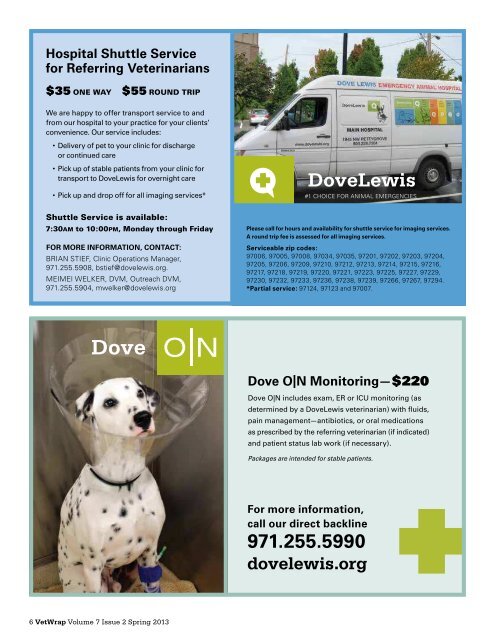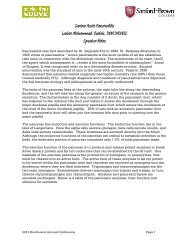VetWrap Spring 2013 - DoveLewis | Emergency Animal Hospital
VetWrap Spring 2013 - DoveLewis | Emergency Animal Hospital
VetWrap Spring 2013 - DoveLewis | Emergency Animal Hospital
You also want an ePaper? Increase the reach of your titles
YUMPU automatically turns print PDFs into web optimized ePapers that Google loves.
Fluid Therapy<br />
<strong>Hospital</strong> Shuttle Service<br />
for Referring Veterinarians<br />
$35 ONE WAY $55 ROUND TRIP<br />
We are happy to offer transport service to and<br />
from our hospital to your practice for your clients’<br />
convenience. Our service includes:<br />
• Delivery of pet to your clinic for discharge<br />
or continued care<br />
• Pick up of stable patients from your clinic for<br />
transport to <strong>DoveLewis</strong> for overnight care<br />
• Pick up and drop off for all imaging services*<br />
Shuttle Service is available:<br />
7:30AM to 10:00PM, Monday through Friday<br />
For more information, contact:<br />
Brian Stief, Clinic Operations Manager,<br />
971.255.5908, bstief@dovelewis.org.<br />
MeiMei Welker, DVM, Outreach DVM,<br />
971.255.5904, mwelker@dovelewis.org<br />
Please call for hours and availability for shuttle service for imaging services.<br />
A round trip fee is assessed for all imaging services.<br />
Serviceable zip codes:<br />
97006, 97005, 97008, 97034, 97035, 97201, 97202, 97203, 97204,<br />
97205, 97206, 97209, 97210, 97212, 97213, 97214, 97215, 97216,<br />
97217, 97218, 97219, 97220, 97221, 97223, 97225, 97227, 97229,<br />
97230, 97232, 97233, 97236, 97238, 97239, 97266, 97267, 97294.<br />
*Partial service: 97124, 97123 and 97007.<br />
Dove O|N Monitoring—$220<br />
Dove O|N includes exam, ER or ICU monitoring (as<br />
determined by a <strong>DoveLewis</strong> veterinarian) with fluids,<br />
pain management—antibiotics, or oral medications<br />
as prescribed by the referring veterinarian (if indicated)<br />
and patient status lab work (if necessary).<br />
Packages are intended for stable patients.<br />
Article<br />
Ladan Mohammad-Zadeh, DVM DACVECC<br />
Fluid therapy is a topic that we all learned from day one in<br />
veterinary school. Although it is a fundamental part of many<br />
of our therapies, it is far from a basic concept. This review of<br />
fluid therapy will start with understanding fluid compartments,<br />
osmotic and oncotic pressures, review the fluid types available<br />
and the ‘when’ and ‘where’ of fluid therapy. Lastly, we will<br />
review certain common scenarios in general practice and the<br />
role of fluid therapy in those situations.<br />
Fluid Compartments<br />
Total body water (TBW) is comprised of 60% intracellular<br />
space and 40% extracellular space. The extracellular space is<br />
further divided into intravascular and interstitial (25% and 75%<br />
respectively). There is a minute amount of space accounted for<br />
in synovial, pericardial, pleural and peritoneal fluids. The major<br />
cations in the intracellular space are K+ and Mg++. The major<br />
anions are PO4- and protein. In contrast, the major cations in<br />
the extracellular space are Ca++ and Na+ and the major anions<br />
Cl- and HCO3-. The balance of fluid between the intravascular<br />
space and the interstitium is governed by hydrostatic and<br />
oncotic forces. The balance of fluid between intracellular and<br />
extracellular compartments is governed by the osmotic effect of<br />
Na+. This is true because membranes are virtually impermeable<br />
to ions but allow water to move freely across membranes.<br />
Important Terminology<br />
Osmolality: A count of the total number of osmotically active<br />
particles in a mass of solution (mOsml/kg).<br />
Effective Osmole: Molecule that has the ability to exert an<br />
osmotic force (i.e. can cause water pull). Typically these particles<br />
are not freely moveable across membranes. These include Na+,<br />
K+, and Glucose.<br />
Ineffective Osmole: Molecules that do not exert an osmotic force.<br />
Usually these particles freely move across membranes. They<br />
include urea and HCO3-.<br />
Tonicity = Effective Osmolality: This is the sum of the<br />
concentrations of solutes which have the capacity to exert an<br />
osmotic force across the membrane. Na+ is the main osmole that<br />
affects water balance between the intracellular and extracellular<br />
fluid. In practical terms, tonicity reflects Na+ concentration of a<br />
fluid. The following is a commonly used equation for osmolality.<br />
Eighteen and 2.8 are the molecular weight of the molecule<br />
divided by 10 to get the correct unit conversion. The normal<br />
serum osmolality is 290 – 310 mOsm/L. Cats may run on the<br />
higher end of normal. The following equation is the calculation<br />
for osmolality:<br />
2(Na + K) +<br />
BUN + Glucose<br />
2.8 18<br />
Calculating a patient’s osmolality can help estimate the degree<br />
of intracellular dehydration. The higher the osmolality, the more<br />
water will need to shift out of the intracellular space into the<br />
extracellular space to compensate, resulting in intracellular<br />
dehydration. Severe hyperosmolality can lead to neurologic<br />
signs and weakness.<br />
It is easy to confuse the terms osmolality and tonicity. It is helpful<br />
to think in terms of tonicity representing the sodium content<br />
and osmolality representing all of the effective osmoles in a fluid.<br />
For example, 0.9% NaCl is both isotonic (154 mEq/L NaCl) and<br />
iso-osmolar (308 mOsm/L). Five percent dextrose in water, D5W,<br />
is hypotonic (0 mEq NaCl) but iso-osmolar (252 mOsm/L) because<br />
of the dextrose concentration. For IV solutions that are meant to be<br />
used over many hours to days, solutions must be iso-osmolar in order<br />
to decrease the risk of phlebitis. For short term infusions however,<br />
it is acceptable to infuse hyperosmolar solutions such as 7.5% NaCl<br />
which is both hypertonic (1232 mEq Na/L) and hyperosmolar (2464<br />
mOsm/L). Mannitol is unique because technically it is hypotonic, but<br />
is hyperosmolar (1098 mOsm/L) and does cause fluid shifts out of the<br />
intracellular and interstitial spaces. This is why it is primarily used to<br />
treat cerebral edema.<br />
Oncotic Pressure<br />
Colloid osmotic pressure is the pressure exerted against the flow<br />
of water out of the intravascular space. Hydrostatic force can be<br />
seen as its opposite, that is, the pressure of water flow out of the<br />
intravascular space into the interstitium. Colloid osmotic pressure<br />
(COP) is synonymous with oncotic pressure. Albumin imparts<br />
80% of the COP in the intravascular space. Thus, it is easy to<br />
understand how hypoalbuminemia and the associated drop in COP<br />
results in fluid shifts out of the intravascular space. Starling’s forces<br />
describe the effect of hydrostatic pressure and oncotic pressure on<br />
both the interstitial side and capillary side. It dictates the direction<br />
of water in or out of the plasma space. In arterial capillaries, the<br />
hydrostatic pressure is slightly greater than oncotic pressure,<br />
favoring filtration, or movement of the water into the interstitium.<br />
On the venous side, oncotic pressure is slightly higher favoring<br />
fluid movement into the plasma space.<br />
Fluid Therapy Plan<br />
When you are deciding on a fluid therapy plan, it might be useful to<br />
pose the following questions: Is fluid therapy indicated? What type<br />
of fluid should be given? By what route should the fluid be given?<br />
How rapidly should fluid be given? How much fluid should be given?<br />
Assessing hydration is something we all do as part of our complete<br />
physical exam. Determining the level of dehydration in our patients<br />
is a combination of physical exam parameters (usually mucous<br />
membrane and skin tent), history of losses or lack of water intake,<br />
and lab parameters such as PCV/TS and urine specific gravity. Skin<br />
tent is not a reliable indicator of interstitial hydration in pediatric<br />
patients and geriatric patients. Levels of dehydration include: 5-6%<br />
mild, 7-10% moderate, and 10-12% severe. A patient is clinically<br />
moribund at a level of 15% dehydration.<br />
To answer the question of what type of fluid should be given,<br />
there are only a few major categories of fluid types to choose<br />
from. Crystalloids are solutions containing electrolyte and nonelectrolyte<br />
solutes capable of entering all body fluid compartments.<br />
Within one hour of administration, two thirds redistributes into the<br />
interstitium and one third stays in the intravascular space. Isotonic<br />
fluids are meant for interstitial rehydration or maintenance. Hypotonic<br />
fluids target intracellular rehydration. Hypertonic fluids are<br />
meant for intravascular volume expansion or to create interstitial<br />
volume dehydration. Most crystalloids, other than 0.9% NaCl and<br />
0.45% NaCl/2.5% dextrose, are considered balanced solutions.<br />
A balanced solution is buffered, isotonic and contains electrolytes.<br />
Saline is an acidic fluid and when given in large volumes may<br />
exacerbate underlying acidosis or delay normalization of pH.<br />
Balanced crystalloids are buffered, making them more alkaline.<br />
Other terms that are used to describe crystalloids are replacement<br />
and maintenance. Replacement fluids contain an electrolyte profile<br />
similar to extracellular space (higher Na+ and less K+), while<br />
maintenance fluids have an electrolyte profile similar to intracellular<br />
space (lower Na+, higher K+). The advantages of a maintenance<br />
fluid type is that it decreases the Na+ load long term and <br />
6 <strong>VetWrap</strong> Volume 7 Issue 2 <strong>Spring</strong> <strong>2013</strong> <strong>Spring</strong> <strong>2013</strong> Volume 7 Issue 2 <strong>VetWrap</strong> 7



